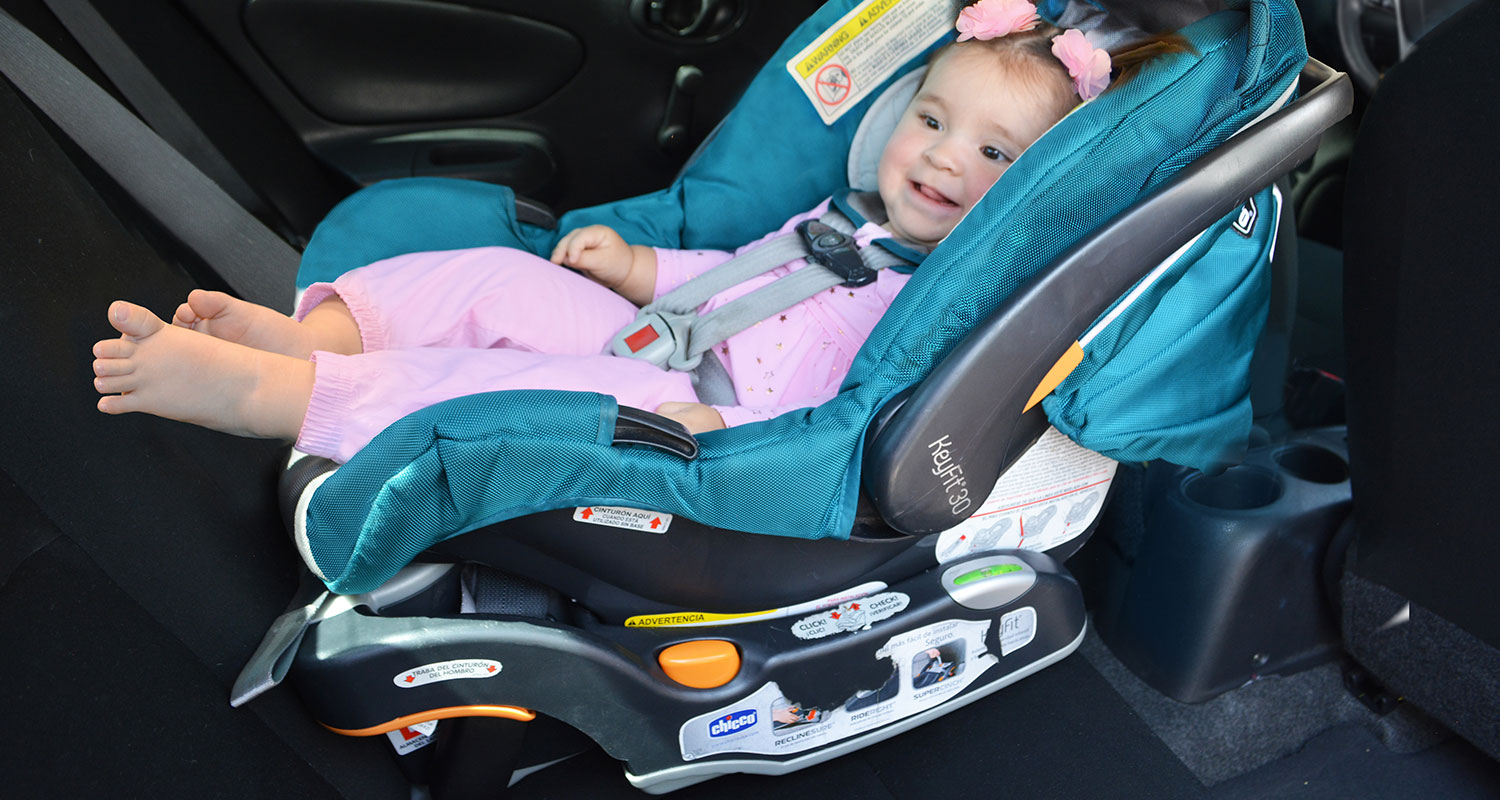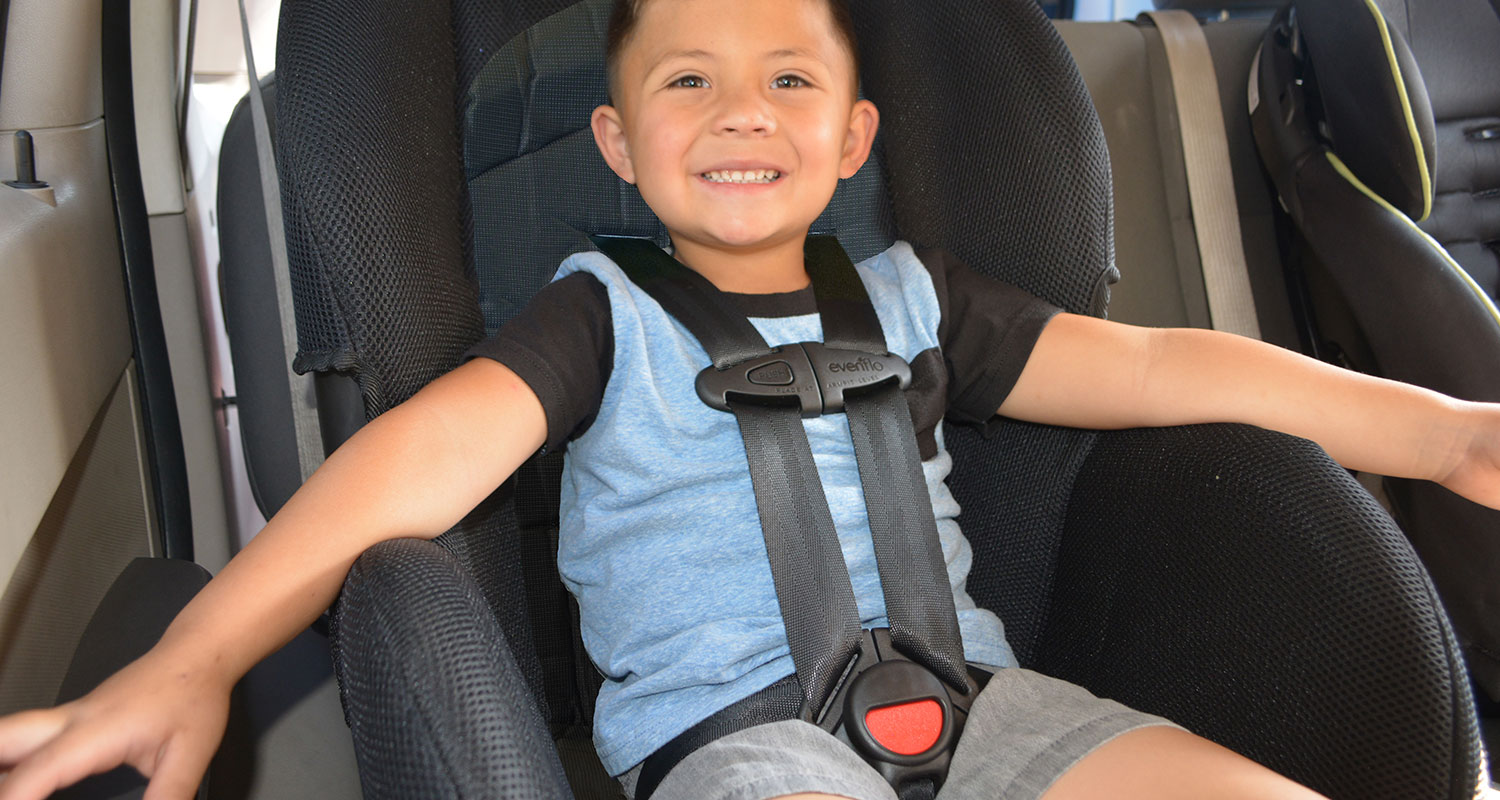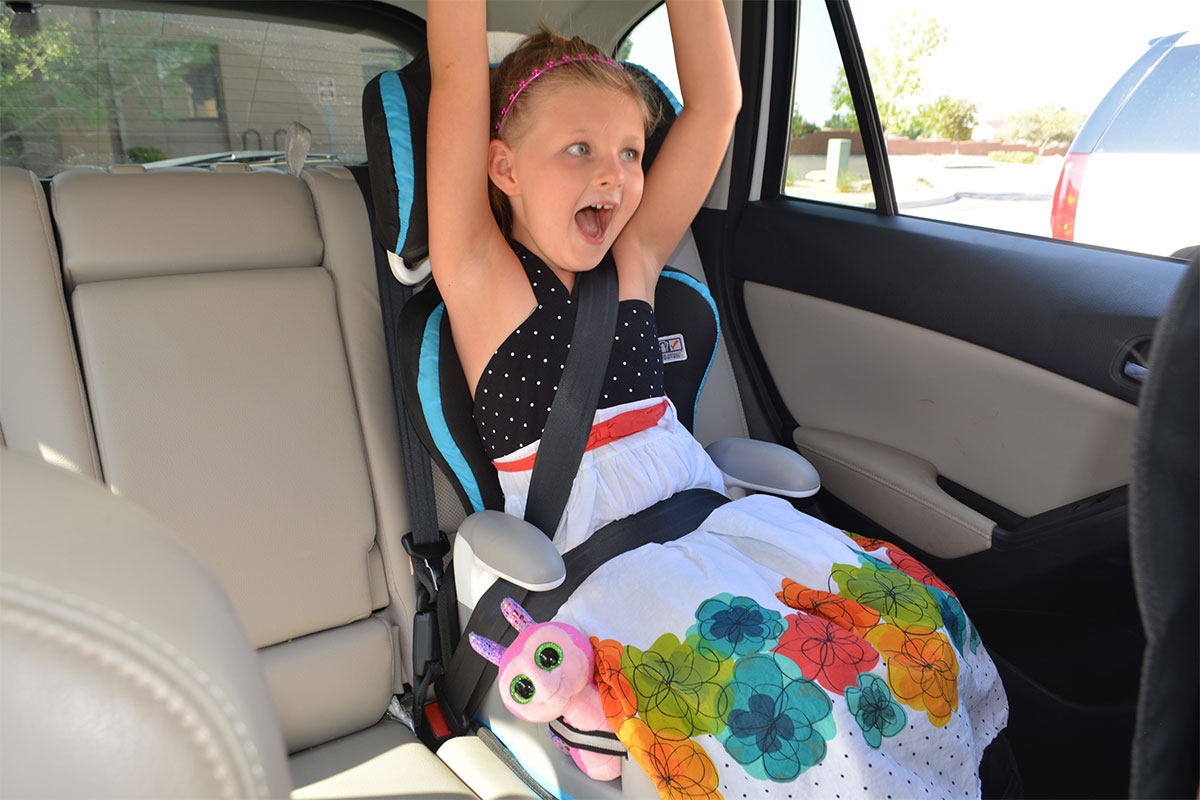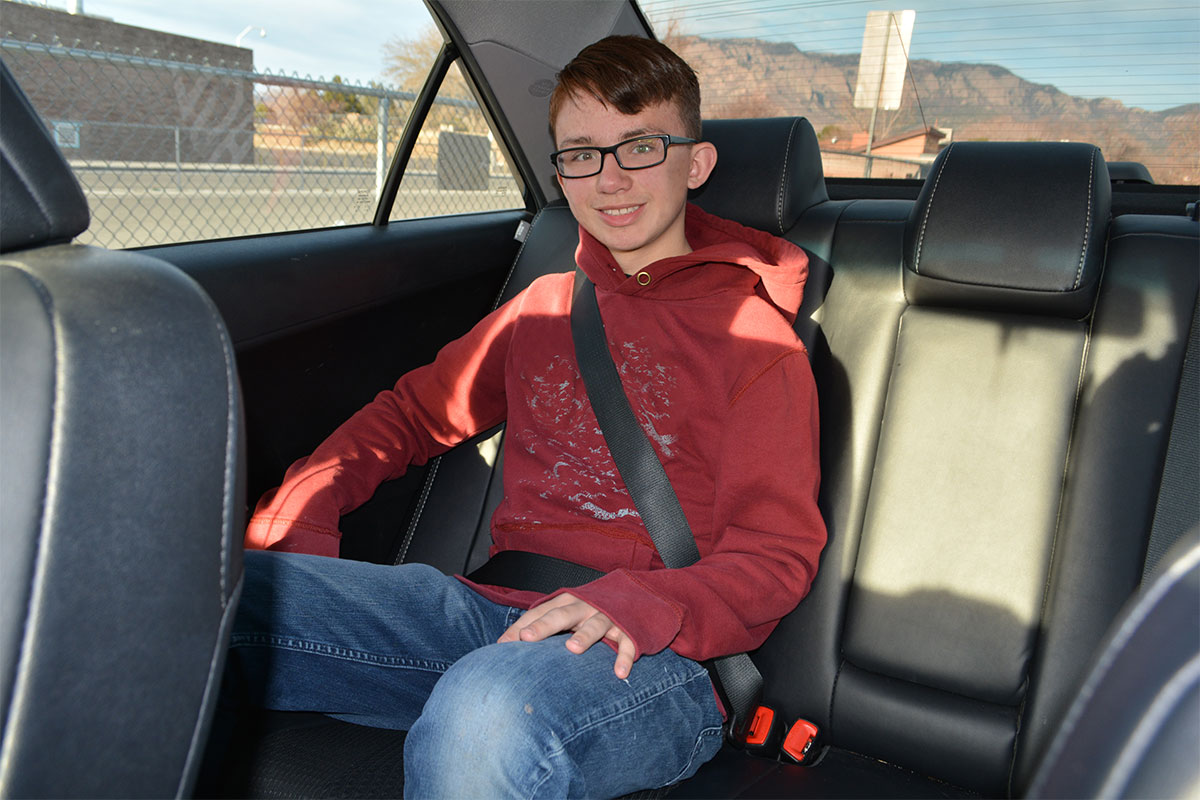Car Seats
An estimated 3 out of 4 car seats are used incorrectly.




What is a Car Seat?
There are several different types of car seats, including infant seats, convertible seats, and booster seats. Each type of seat has specific age, height, and weight restrictions and must be installed in a particular way. The law in New Mexico requires all children up to their 7th birthday, regardless of weight, and all children less than 60 pounds, regardless of age, to ride in a car seat or booster seat. The law also states that children age 7 through 12 must ride in a booster seat until the adult seat belt fits them properly.
What Type of Seat does My Child Need?
There are several types of car seats. Safer New Mexico Now describes each one below. The right seat is the one that fits your child, your vehicle, and the one that you can use correctly every time.
For more information, please visit their website.
Rear-Facing Car Seats
Young children have heavy heads and small, flexible bodies. Facing the back of a car, truck, or van in a rear-facing car seat is safer than facing the front. The car seat supports the child’s head and neck and spreads crash energy across the entire back. The National Highway Traffic Safety Administration provides guidance that all children ages 1 to 3 remain rear facing until they reach the highest weight or height limit allowed by the car seat manufacturer. New Mexico law also requires following manufacturer instructions, including specific age, weight, and height requirements.
By law, all children must remain rear facing until they are at least 1 year of age and 20 pounds; however, children between the ages of 1 and 2 are 5 times less likely to be injured in a crash rear facing compared to forward facing! ALL children should stay rear facing as long as possible, up to the weight or height limit of a rear-facing seat (most convertible models can be used up to 30 or 35 pounds).
Forward-Facing Car Seats
As children grow, they still need extra protection. The straps on a forward-facing car seat adjust to fit small children well and spread crash energy across the strongest parts of a child’s body – the shoulders, chest, and hips. Children should ride in forward-facing car seats with a harness and tether until they reach the weight or height limits of the seat allowed by the car seat manufacturer– some models can be used up to 40 or 50 pounds, but others go to 65 pounds or more.
Booster Seats
Once a child has reached the maximum height and weight limit of the forward-facing seat, it’s time to graduate to a booster seat. Booster seats position the child to allow the seat belt to fit properly. The belts need to be on the strong and bony parts of a child – not on the soft belly or neck – and the shoulder belt must never be behind a child’s back or under an arm. A booster seat is a car seat. It guides the lap and shoulder belts so they fit the child properly. It helps prevent serious injuries and makes the child comfortable. Children should ride in booster seats until the vehicle seat belt fits correctly. Booster seats cannot be used with a lap belt alone – they must be used with vehicle lap and shoulder belts.
Seat Belts
Children who fit correctly in seat belts should use both lap and shoulder belts in cars, trucks, and vans. The belts contact strong areas of a child’s body and spread crash energy over a wide area. To see if the belt fits correctly, have the child sit all the way back on the car, truck, or van seat and buckle the belt. The lap belt should stay snug below the hip bones and touching the upper thighs, and the shoulder belt should stay against the chest and shoulder. The child’s knees should also bend naturally over the vehicle seat edge to help keep the belts in position. If the seat belt sits across the soft belly or neck, it does not fit correctly and could contribute to injuries. In this case, the child should still ride with a booster seat.
Which Car Seat Is the Best?
Safer New Mexico Now does not recommend or condemn any specific brand or model of car seat sold in the United States unless it has been recalled. The best car seat for you is the one that fits your child, fits your vehicle, and is used consistently and correctly. The seat you choose should be free of recalls and should have labels indicating it meets all appropriate federal standards. You should never use a car seat that has been altered, is missing parts, or has been involved in a moderate to severe crash.
What Is the Law in New Mexico?
All occupants must be properly restrained in all seating positions. Violators must pay a $25 fine plus court fees (which vary by jurisdiction)and receive 2 driver’s license points against their driving privilege.
A child under age 1 must ride in a rear-facing car seat in a back seat. If the vehicle has no back seat, a child under age 1 can ride in a front seat if the air bag is deactivated or if the vehicle does not have an air bag deactivation switch.
IMPORTANT: The National Highway Traffic Safety Administration recommends NEVER putting a rear-facing car seat in front of a front passenger air bag.
- A child age 1 through 4 must ride in a car seat.
- A child under 40 pounds must ride in a car seat.
- A child age 5 through 6 must ride in a car seat or booster seat.
- A child under 60 pounds must ride in a car seat or booster seat, regardless of age.
- A child age 7 through 12 must be properly restrained in a car seat, booster seat, or seat belt (see below for seat belt proper fit).
- A child age 13 through 17 must ride in a seat belt.
Why Should I Properly Restrain My Child?
Crashes are violent events. When a car, truck, or van suddenly stops in a crash, everyone and everything inside keeps moving. Car seats and seat belts help manage that energy so our bodies don’t need to.
Traffic crashes are a leading cause of unintentional deaths and severe injuries in the U.S., and unintentional injuries are the leading cause of childhood deaths. Many of these deaths and injuries are predictable and preventable. For every injury-related death, there are 45 children hospitalized and many more needing medical care in emergency rooms or doctors’ offices. Car seats are 71% effective in reducing deaths for infants in passenger cars. They are 54% effective in reducing deaths for children ages 1 to 4 in passenger cars. They reduce the need for hospitalization by 69%. Overall, car seats are a highly cost effective investment.
Source: National Highway Transportation Safety Administration National Standardized Child Passenger Safety Training Program Curriculum
What Are Ease-of-Use Ratings?
The National Highway Transportation Safety Administration (NHTSA) has developed a set of ratings for car seats based on their ease-of-use.
- Evaluation of Instructions Examines the content and clarity of the instructions manual for the child restraint.
- Vehicle Installation Features Examines the ease of using features that pertain to installing the child restraint in a vehicle.
- Evaluation of Labels Examines the content and clarity of the labeling attached to the child restraint.
- Securing the Child Examines the ease of using features that pertain to securing a child correctly in the restraint.
What Do the Ratings Mean?
NHTSA uses the following rating system to help you evaluate the four basic categories above:
- 5 Stars = Excellent features on this child restraint for this category
- 4 Stars = Above-average features on this child restraint for this category
- 3 Stars = Average features on this child restraint for this category
- 2 Stars = Below-average features on this child restraint for this category
- 1 Star = Poor features on this child restraint for this category
N/A = Does not contain any features that require a rating. For more information, please visit their website.
How will I Know if My Child's Safety Seat has been Recalled?
If you mailed in the registration card with your current address when you purchased your child's safety seat, the seat manufacturer will notify you by mail of any recalls associated with your particular seat. If you did not register your seat or have relocated, you can visit the website for the manufacturer of your specific seat. Look for a “Product Registration” or “Recall” page within that website. You will need to have the model number and date of manufacture from the seat itself. This information is located on the hard plastic portion of the seat, usually on a sticker on the back or bottom of the seat. Also see our list of Manufacturers' websites. There are also several comprehensive recall lists compiled by reputable agencies. Again, you will need the model number and date of manufacture from your child's safety seat before you use these lists.
How do I Know if My Child Needs to be Riding in a Booster Seat?
The law in New Mexico states that all children 5 through 6 years old who have outgrown their car seats have to ride in a booster seat, regardless of how much they weigh. Also, children ages 7 through 12 must ride in a booster seat until the adult seat belt fits them properly.
How will I Know if the Adult Seat Belt Fits My Child Properly?
If your child is NOT riding in a booster seat, try this 5-step test:
- Does my child sit all the way back against the vehicle seat?
- Do my child's knees bend comfortably at the edge of the vehicle seat?
- Does the lap belt fit across my child’s upper thighs and hips (not across the abdomen)?
- Does the shoulder strap fit across the center of my child’s chest (and not across the neck)?
- Can my child stay seated like this for the entire trip?
If you answered “no” to any of these questions, your child needs a booster seat to ride more safely in the car. Riding in a booster seat is more comfortable, too!
Are You Using the Right Seat?
Safer New Mexico Now can help you know for sure if the car seat or booster seat you’re using is the best fit for your child. You can make an appointment with a Certified Child Passenger Safety Technician to have your car seat or booster seat inspected. Visit safernm.org for more information or call 1-800-231-6145 to make an appointment.



